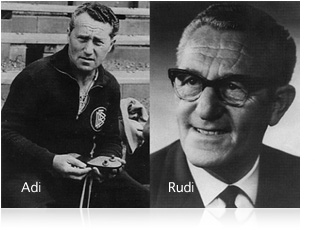
Adolf Dassler, popularly known as ‘Adi’, made sports shoes in his mother’s laundry room in Herzogenaurach, Germany after returning from World War I. In July 1924, his older brother Rudolf joined the business, and they called it Dassler Brothers Shoe Factory (Gebrüder Dassler Schuhfabrik).
The brothers went through a lot of hardships at that time. The electricity supply in Herzogenaurach was unreliable, so the brothers had to use pedal power from a bicycle to run their equipment. The brothers assisted in the development of spiked running shoes for multiple athletic events. To enhance the quality of spiked athletic footwear, Adi shifted from a previous model of heavy metal spikes to using canvas and rubber instead. In 1936, they persuaded U.S. sprinter Jesse Owens to use their spikes, which Adi made with his own hands, at the 1936 Summer Olympics. With those shoes, Owens won four gold medals, and the name and reputation of Dassler shoes became known to sportsmen and trainers worldwide. Their business was extremely successful and the Dasslers were selling 200,000 pairs of shoes every year until World War II. During the war, the company was running the only sport shoe factory in German and mostly supplied shoes to the Wehrmacht, the German military.

In 1948, after over 30 years of working together, Adolf and Rudolf abruptly separated, due to differences in opinion for the future of the company. The same year, Rudolf established his company, Ruda (short for Rudolf Dassler) but later renamed to Puma after the animal. In 1949, Adolf established Adidas (short for Adi Dassler). The original Dassler Brothers Company’s workforce and resources were split between the brothers. Adidas kept the factory by the train station and two-thirds of company’s employees, as most employees believed Adi’s vision of focusing on product development rather than Rudolf’s sales-oriented approach. Rudolf kept remaining workforce and the factory on Würzburger Street.
In the following three decades, both Adidas and Puma rose to dominance and signed deals with athletes. Adidas famously sponsoring professional American boxer Muhammad Ali and Joe Frazier and Puma signing with Brazil national football team. Adidas introduced shoes customized for different sports, and grew rapidly while Puma, driven by Rudolf’s sales approach, kept chasing Adidas throughout these decades, without making much innovations on its own.

It’s said that the Dassler family quarrels were so extreme that the Puma and Adidas families went to separate bakeries, separate butchers, as well as separate pubs. Michael Dassler, the grandson of Puma’s founder, said Adidas employees going into a shop that Puma employees visited, and vice versa, was impossible. He recalls that in his childhood, contact between his grandfather Rudolf and his brother was non-existent. “In our home, the name Adidas was never mentioned,” he said. Families of their home town either identified with Puma or Adidas, never both. When Adolf (in 1978) and Rudolf (in 1974) died, they were buried at opposite ends of the town cemetery.
Now, Adidas has a market value of US$15.6 billion, while Puma values at US$4 billion. Even after 70 years, Adidas and Puma still go head-in-head competing with each other, spending billions of dollars every year for research and development to come up with the next big product to drive customers to their brand.




0 Comments